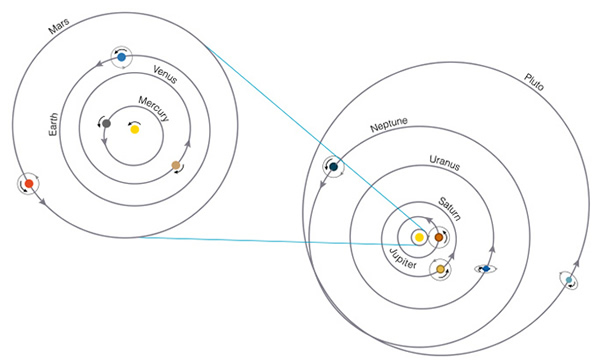
We have now completed our tour of the solar system and have seen what is out there, what the planets are like (sizes, temperatures, composition). Now we retreat a little to ask the question, how did the solar system form, and what did it form from? We have had some hints along the way, for example the Sun has 99.86% of the mass of the solar system and it is 75% hydrogen, and 24% helium--similar to the Jovian planets. Thus, this is probably a good guess at the initial composition of the material from which our solar system formed. But there are many other clues and questions. Let's first look at how the planets move--that is what direction do they move in, and what direction do they spin in? This is demonstrated in the figures, below: the direction of the motions of the planets around the Sun is indicated, as is the spin of the planets:

All of the planets orbit the Sun in the same direction (counterclockwise as seen from above the north pole of Earth). Note that just about all of the planets spin in the same direction they orbit (the exceptions are Venus, Uranus, and Pluto), and this is in the same direction in which the Sun rotates. Note also that most of the biggest moons (those little circles that look like epicycles) of each of the planets orbits around their planet in the same direction the planet spins. If we look at how the orbits are arranged, we see that they almost lie in a single plane (except Pluto and, to a lesser degree, Mercury):
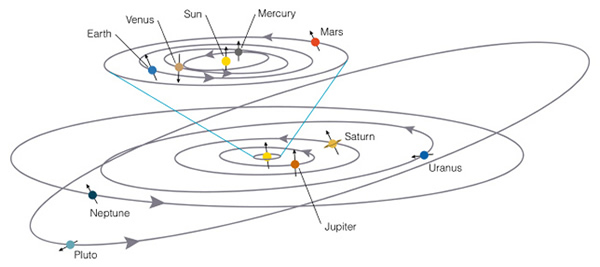
This highly ordered system suggests that the planets formed in a disk-like structure that was spinning in one direction. This disk of material from which the planets formed has been given the name of the "protoplanetary disk" (proto means "earliest of" or "coming before"). When we look into the solar system, we do not see many disk-like objects. Except for Saturn's rings (and lumpy asteroids), just about everything we see is spherical. This is because the particles that comprise an object pull on all other particles in the object due to gravity. Large objects are spherical because the gravitational pressure pulls them into a spherical shape. Small objects like asteroids, have such low gravity that the rocks are strong enough to resist it, and they can support a non-spherical shape:
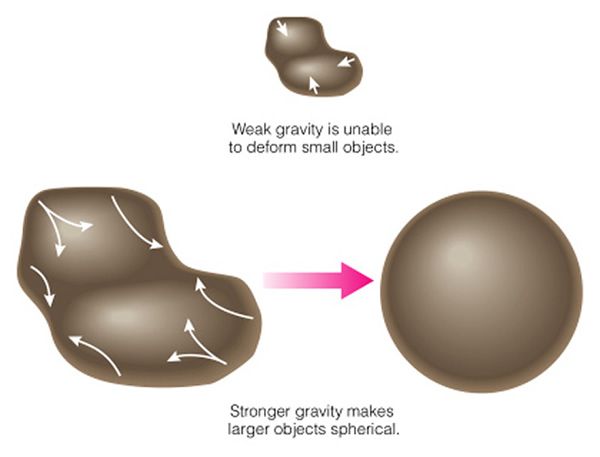
The cloud of gas and dust from which the solar system formed also probably started out with a spherical shape. At first, this cloud was of low density, and very cold. But gravity keeps pulling on matter, so the cloud would begin to shrink. As it shrinks, the density goes up, and with higher density comes higher temperatures. Also, as the cloud collapses, it begins to flatten, eventually assuming a disk-like shape:

This is the same process that ice skaters use to spin during performances. They start spinning with their arms extended, and as they pull in their arms they spin faster and faster. As a cloud of gas collapses, the initial slow spin gets amplified. As it spins, the cloud flattens. Eventually you end up with a disk. Thus, the disk-like structure of the solar system implies that it formed in a disk, and this disk probably started out life as a large, spherical cloud of gas and dust. As shown in Figure 8.4 of the textbook, we see similar disk like objects around other stars that probably represent young solar systems:
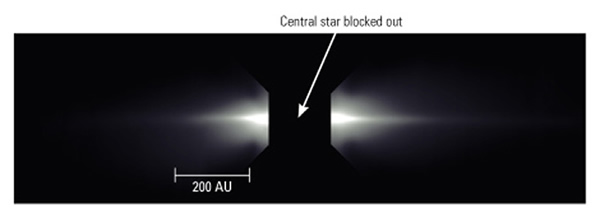
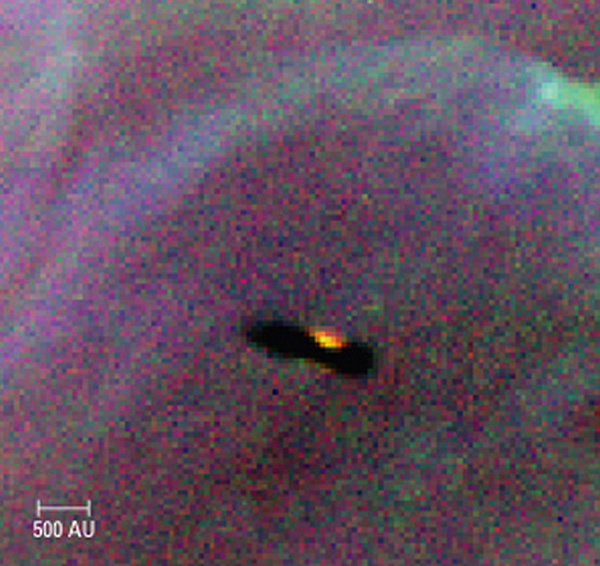
What was the composition of the initial cloud of gas and dust? The Sun, and the Jovian planets tell us that the gas from which the solar system formed was mostly hydrogen and helium. In fact, they account for 98% of all of the elements in the solar system! We can understand why the planets are the way they are by looking at the temperatures at which various materials (molecules and elements) condense from a gaseous state to a solid state. This is done in Table 8.1 of the book:

Hydrogen and helium do not condense to a solid state in a gas cloud (hydrogen becomes metal-like at the core of a planet, but at most temperatures and densities hydrogen is a gas). After hydrogen and helium, the most abundant materials in the solar system are water, methane and ammonia (molecules composed of hydrogen, and the elements oxygen, carbon, and nitrogen, respectively). As shown in today's homework assignment, these gases freeze at very low temperatures. Today we find these gases/ices in places where the temperature was very low in the early days of the solar system. As shown in the next homework assignment, this is out beyond the planet Earth for most ices (except water). This implies that when the solar system was forming, it never was probably warm enough to "melt" these ices out beyond Jupiter. That's why we believe comets are nearly pristine material from the earliest days of planetary formation. The temperature difference between the innermost part of the solar system (close to the "proto-Sun" where it is hot), and the outer regions (where it is cold) sets up the conditions which lead to the terrestrial vs. Jovian planet distribution (Fig. 8.5):
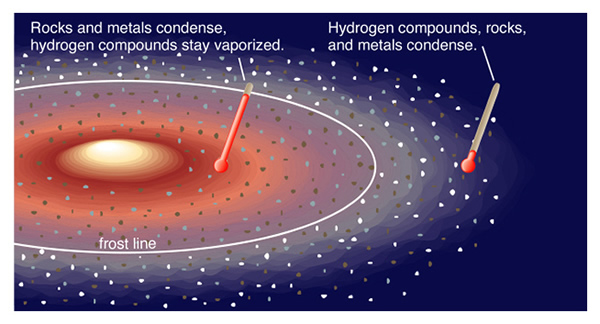
This is not to imply that there was no water, methane and ammonia in the inner solar system, there was and is(!)--but it was in a gaseous state, and it required a large planet to hold onto it. Gases heat up, and move around, so you need a force to overwhelm this motion, and that force is gravity.
At first, there were lots, and lots of planets. Most of them very small--we call them "planetesimals". When two planetesimals happen to get close to each other, the gravity of the larger one attracts the smaller one, and they can merge together to form an even larger planetesimal. This process is called "accretion". It is like rolling a snowball down a hill, the snowball starts out small, but grows as it "accretes" more material (snow). Figure 8.6 of the text shows the process for the inner solar system:

The structure of meteorites (see figure 8.7 on page 234) shows the evidence for this accretion process:
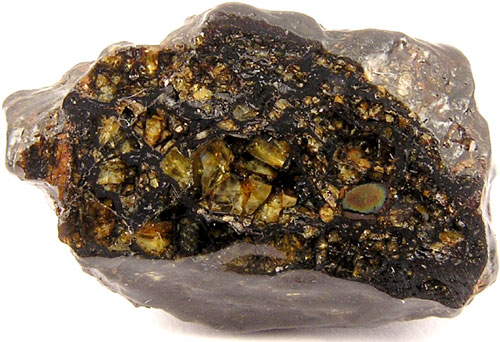
Most meteors are composed of smaller clumps of metal crystals and grains of rocky material. The Jovian planets formed out where it was cold enough to accrete many larger frozen objects like comets, and where there was plenty of cold hydrogen gas:
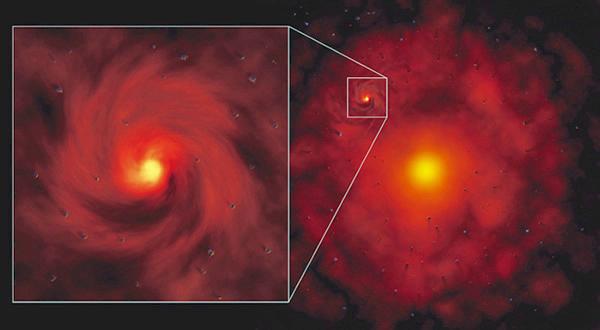
As these planetesimals grew into the sizes of asteroids, and small planets, the nebula that formed solar system was getting thin, as it was being condensed into smaller, denser units. As the Sun finally grew to a size large enough to ignite hydrogen fusion in its core, it heated up the entire nebula, and the gas and dust was dispersed by solar radiation. Of course, it was also during this time when the bombardment of the planets was going on, and when the Moon was formed by a collision of a Mars-sized object with the Earth):
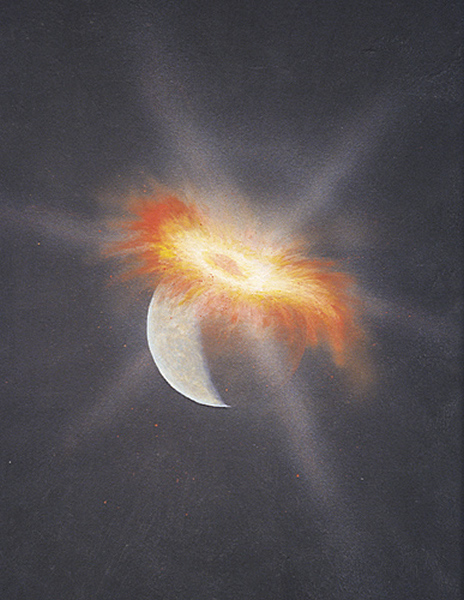
This scenario explains the structure we see today. Some objects in the solar system retain the scars of numerous collisions with planetesimals, asteroids, comets, and meteors. Both Mars and the Earth were hit by large objects. On Mars we see a "lopsided" planet, where one hemisphere is more massive than the other. In the case of the Earth, the collision formed the Moon. But Venus also shows signs of having been hit by something large. As shown in the diagram at the top of this page, Venus rotates opposite to the other planets--this backwards ("retrograde") rotation might have resulted from a collision early in its formation history that flipped the planet over (though this event did not create a Venusian moon for some reason)! The same type of thing must have happened to Uranus.
The big moons of Jupiter and Saturn probably formed in-place. In a way, the regions around Jupiter and Saturn were like their own mini-solar systems, with the moons growing out of material in orbit around the proto-planet. Both Pluto and Neptune's moon Triton are similar in size and composition, and are in odd orbits. Triton orbits Neptune in a retrograde fashion, while Pluto is on a highly elliptical, and inclined orbit that at one time probably intersected with Neptune. Some researchers propose that Pluto was once a moon of Neptune, and that an encounter between Triton, Pluto and Neptune sent Pluto flying off on its orbit, while Triton was "captured" by Neptune, going into orbit in the opposite direction after coming close to Pluto. Maybe this event also broke-up Pluto creating its moon Charon. Someday we may know the answer once we have gone to both Triton and Pluto and can determine their chemical compositions more accurately, as well as map their internal structure.
A summary of the process is shown in Fig 8.13 from the textbook:

The scenario we have outlined, the "nebular theory", accounts for the structure of the solar system. We now have seen similar types of structures around other stars, and this theory is now the established explanation for the formation of the solar system. When did all of this occur? We have mentioned that the Earth, Moon, and meteorites all appear to be about 4.5 billion years old. This is when we believe the solar system first started to come together in the disk-like configuration. How do we know this? That will take a little nuclear physics to understand.
"On March 1, 1896, Henry Becquerel made one of the most important discoveries of our time by accident. Becquerel put a couple of photographic plates that were completely sealed in paper in a drawer next to a rock, identified as uranium ore, and left them there. After a few days, he developed the plates and discovered strange bright spots . Becquerel discovered that uranium gives off invisible rays. Although we cannot see these rays, they will cause photographic materials to react, just as visible light causes film to be exposed. The invisible rays from the uranium ore were able to pass directly through paper and cause the bright spots that formed on Becquerel's photographic plate. Materials that give off such invisible rays are said to be radioactive ."1
Becquerel made his discovery just one year after the German Physicist Roentgen had discovered the "X-ray" , a new form of high energy light that could penetrate through a variety of materials. Within a few years, Pierre and Marie Curie had conducted experiments to show that the radioactive decay of uranium produced x-rays, and had termed the phenomenon "radioactivity". They also found that the result of radioactive decay was a daughter element. For example, through decay, uranium turned into lead. Other elements were found to have other final isotopic daughter products:
Radioactive Parent |
Stable Daughter |
|---|---|
Potassium 40 |
Argon 40 |
Rubidium 87 | Strontium 87 |
Thorium 232 | Lead 208 |
Uranium 235 | Lead 207 |
Uranium 238 | Lead 206 |
Carbon 14 | Nitrogen 14 |
At the turn of the century, Ernest Rutherford was experimenting with radioactivity and discovered that specific radioactive elements had a constant decay rate. That is, over time, the total radioactivity of an element (like uranium) decreases. Some elements had faster decay rates than others:
Radioactive Parent |
Stable Daughter |
Half life |
|---|---|---|
Potassium 40 |
Argon 40 |
1.25 billion yrs |
Rubidium 87 | Strontium 87 | 48.8 billion yrs |
Thorium 232 | Lead 208 | 14 billion years |
Uranium 235 | Lead 207 | 704 million years |
Uranium 238 | Lead 206 | 4.47 billion years |
Plutonium 239 | Lead 207 | 24,400 years |
Carbon 14 | Nitrogen 14 | 5730 years |
The decay in the numbers of the parent, and the growth in the daughter element can be shown in the following graph2:
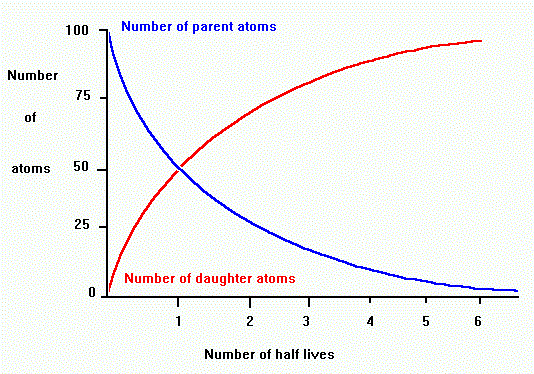
The half-life that is used to measure radioactive decay is the time it takes for half of the sample (say pure uranium) to turn in to its daughter product (say lead):
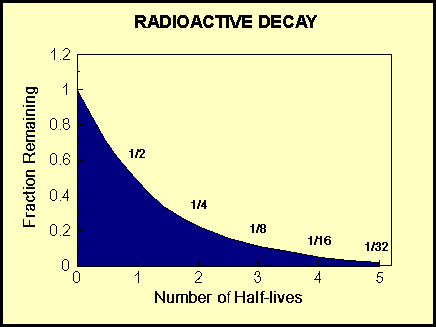
In 1907 Yale Physicist B. B. Boltwood came up with the brilliant idea that the measuring of the fractional composition of radioactive elements in rock samples/layers could give you their ages! He quickly proceeded to estimate an age for the Earth using this technique, and derived an answer of 2.2 billion years. More than a factor of 10 times older than most existing estimates.
With the development of the mass
spectrometer in the 1920's, which separated-out various elements and
isotopes in a rock sample, geologists could begin to
determine ages of the various rock layers that they were
investigating, and put together a history of rock formations (go here for a more
indepth history of the development of geological dating and stratigraphy). This was how the history of the Earth has been unraveled,
and these techniques were applied to both Moon rocks and to meteorites
(including those from Mars). The oldest stuff in the solar system is about
4.54 billion years old.
1 From
"Radioactivity and Nuclear Reactions" by Beatrice Foots that used to be at
http://www.uh.edu/hti/curriculum_units/chemistry/Foots_Unit.htm
2 From "Radiometric Dating" at http://www.dc.peachnet.edu/~pgore/geology/
geo102/radio.htm